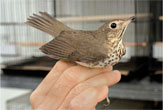
To help make up for sleep lost during marathon night flights, migratory birds take hundreds of powernaps during the day, each lasting only a few seconds, a new study suggests.
Every autumn, Swainson's thrushes fly up to 3,000 miles from their breeding grounds in northern Canada and Alaska to winter in Central and South America. Come spring, the birds make the long trek back.
The birds fly mostly at night and often for long hours at a time, leaving little time for sleep.
To find out how the birds get through these tiresome periods, scientists observed caged thrushes for an entire year, recording when and how long they slept. They found that during autumn and spring, when the birds are normally migrating, they reverse their typical sleep patterns, staying awake at night and resting during day.
But instead of sleeping for long stretches at a time, the birds took several naps a day, each one lasting only 9 seconds on average.
The thrushes also mixed up their shut-eye sessions with two other forms of sleep. In one, called unilateral eye closure, or UEC, the birds rested one eye and one half of their brains while their other eye and brain hemisphere remained open and active, keeping them semi-alert to danger.
The birds also occasionally slipped into another state, one that any college student who has ever been stuck in a boring lecture can relate to. Called drowsiness, this state is characterized by a partial shutting of both eyes that still allows for some visual processing.
Get the world’s most fascinating discoveries delivered straight to your inbox.
Drowsiness "is probably a state that, to some extent, grants the benefits of sleep while allowing for some of the benefits of wakefulness," said study team member Thomas Fuchs of Bowling Green State University in Ohio.
By alternating between naps, UEC and drowsiness, the thrushes and other migratory birds can reap some of the benefits of sleep while only marginally increasing their risks of being eaten, the scientists figure.
"In terms of quality, drowsiness and unihemispheric sleep may be less beneficial than [normal] sleep, but it may also be safer," Fuchs told LiveScience.
The study is detailed this month in the journal Animal Behavior.
Some scientists speculate that some birds might even be able to catch up on some forms of sleep while in flight, but this idea has yet to be fully tested.
The need for sleep is nearly universal in the animal kingdom, but scientists still aren't sure what purpose it serves. Some studies suggest we need sleep to organize the memories we amass during the day and to give our bodies time to rest, but both theories remain unproven.
"I think what's interesting about our findings is that even animals that should be highly adapted to sleep loss cannot go on indefinitely," Fuchs said. "That a need for sleep cannot be eliminated even in these species underscores the importance of sleep for many, if not all, animals."
- Video: Amazing Bird Radar
- Secret of Bird Flight Revealed
- Earlier Spring Starves Migratory Birds
- Sleep Deprivation: The Great American Myth
- Newborn Mammals Don't Sleep for a Month
- The Top 10 Mysteries of the Mind
- Video: Extraordinary Birds


